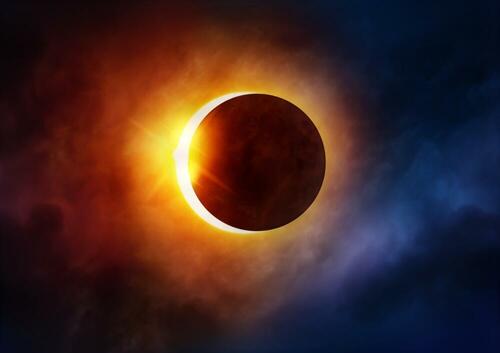Heat Is Radiating From A Huge Mass Under The Moon
The Moon, often seen as a cold and lifeless neighbor, holds secrets that continue to intrigue scientists and stargazers alike. Its surface, marked by craters and barren plains, gives little hint of the mysteries beneath. But recent discoveries have revealed something extraordinary: a massive heat-emitting feature buried deep within the lunar crust.
This enigmatic finding, hidden beneath the Moon’s far side, defies expectations. It involves a rare material, typically associated with Earth, and raises fascinating questions about the Moon’s past. What could cause such heat on a body long thought to be geologically dormant? And what does this mean for our understanding of the Moon—and perhaps even other planets?
The Discovery: Uncovering Lunar Heat
In a groundbreaking revelation, scientists have identified a substantial heat-emitting granite mass beneath the Moon’s surface, specifically near the Compton and Belkovich craters on its far side. This discovery was made possible through data collected by both Chinese and American lunar orbiters, which utilized microwave frequency observations to detect subsurface temperatures. Dr. Matt Siegler of the Planetary Science Institute explained, “We used an instrument that observes microwave wavelengths, longer than infrared, sent to the Moon on both the Chinese Chang’E 1 and 2 orbiters. We found that one of these suspected volcanoes, known as Compton-Belkovich, was absolutely glowing at microwave wavelengths.”
The data revealed a silicon-rich surface feature approximately 20 kilometers wide, believed to be the caldera of an ancient volcano. This area exhibited temperatures about 10°C warmer than its surroundings. Notably, this heat is not due to current volcanic activity, as the last eruption occurred around 3.5 billion years ago. Instead, the heat emanates from radioactive elements trapped within the granite mass. Dr. Siegler noted, “We interpret this heat flux as resulting from a radiogenic-rich granite body below the caldera.”
This finding is significant because granite formation typically requires water and plate tectonics—conditions absent on the Moon. The presence of such a large granite deposit suggests that the Moon’s geological history may be more complex than previously understood. Dr. Siegler remarked, “If you don’t have water, it takes extreme situations to make granite. So, here’s this system with no water, and no plate tectonics—but you have granite.”
The discovery was detailed in a study published in the journal Nature on July 5, 2023. The research team utilized microwave frequency data to measure heat below the surface of the Compton-Belkovich volcanic complex, leading to the identification of the granite mass.
This revelation not only enhances our understanding of the Moon’s volcanic past but also opens new avenues for exploring similar geological features on other celestial bodies. The presence of granite on the Moon challenges existing theories about its formation and suggests that other areas of the Moon, and possibly other parts of the solar system, may harbor similar features.
What Makes Granite Unique?
Granite is a coarse-grained igneous rock predominantly composed of quartz, feldspar, and mica. On Earth, its formation is closely linked to the presence of water and the dynamic processes of plate tectonics. These conditions facilitate the melting of the Earth’s crust, leading to the creation of large magma bodies that cool slowly beneath the surface, crystallizing into granite.
The discovery of a substantial granite mass beneath the Moon’s surface is particularly intriguing because the Moon lacks both water and active plate tectonics—key elements in granite formation on Earth. This raises compelling questions about the geological processes that could have led to the formation of granite in such an environment. As Dr. Matt Siegler of the Planetary Science Institute noted, “If you don’t have water, it takes extreme situations to make granite. So, here’s this system with no water, and no plate tectonics—but you have granite.”
The presence of granite on the Moon suggests that alternative mechanisms may be at play. One possibility is that the Moon’s interior experienced localized heating events, potentially from radioactive decay, leading to partial melting and the formation of granite. This hypothesis is supported by the detection of heat emanating from the granite mass, attributed to radioactive elements trapped within the rock. Dr. Siegler explained, “We interpret this heat flux as resulting from a radiogenic-rich granite body below the caldera.”
Radioactive Heat: The Cause of the Glow
The unexpected heat emanating from the granite mass beneath the Moon’s surface is primarily due to radioactive decay within the rock. Granite is known to contain higher concentrations of radioactive elements such as uranium and thorium compared to other rocks. As these elements decay, they release heat—a process known as radiogenic heating. This phenomenon is well-documented on Earth, where the decay of radioactive isotopes contributes to the planet’s internal heat budget.
In the context of the Moon, the detection of a heat anomaly beneath the Compton-Belkovich volcanic complex suggests the presence of a radiogenic-rich granite body. Dr. Matt Siegler of the Planetary Science Institute explained, “We interpret this heat flux as resulting from a radiogenic-rich granite body below the caldera.”
The presence of such a heat source indicates that the Moon’s interior once contained sufficient radioactive material to sustain prolonged volcanic activity. This challenges previous assumptions about the Moon’s thermal evolution and suggests that its interior was more geologically active than previously thought.
Understanding the role of radiogenic heating on the Moon not only provides insights into its volcanic history but also offers a comparative framework for studying other celestial bodies. For instance, the internal heating of terrestrial planets, including Earth, is significantly influenced by the decay of radioactive isotopes.
Implications for Lunar Geology
The discovery of a substantial granite mass beneath the Moon’s surface, particularly in the Compton-Belkovich region, has profound implications for our understanding of lunar geology. Granite formation typically requires specific conditions, such as the presence of water and plate tectonics—factors absent on the Moon. This finding challenges existing theories about the Moon’s geological processes and suggests that its interior may have been more complex and dynamic than previously thought.
Dr. Matt Siegler of the Planetary Science Institute highlighted the significance of this discovery, stating, “This is more Earth-like than we had imagined can be produced on the Moon, which lacks the water and plate tectonics that help granites form on Earth.”
The presence of granite indicates that the Moon’s crust may have undergone processes leading to the differentiation and evolution of its interior, resulting in the formation of silica-rich rocks. This challenges the traditional view of the Moon as a geologically inactive body and opens new avenues for research into its thermal and magmatic history.
What It Means for Future Exploration
The discovery of a substantial granite mass beneath the Moon’s surface, particularly in the Compton-Belkovich region, has profound implications for future lunar exploration. This finding challenges existing theories about the Moon’s geological processes and suggests that its interior may have been more complex and dynamic than previously thought.
Granite formation typically requires specific conditions, such as the presence of water and plate tectonics—factors absent on the Moon. The presence of granite indicates that the Moon’s crust may have undergone processes leading to the differentiation and evolution of its interior, resulting in the formation of silica-rich rocks. This challenges the traditional view of the Moon as a geologically inactive body and opens new avenues for research into its thermal and magmatic history.
Understanding the Moon’s geological history is crucial for future exploration missions. Identifying areas with unique geological features, such as the granite mass beneath Compton-Belkovich, can help prioritize landing sites for robotic and human missions. These sites may offer valuable insights into the Moon’s evolution and provide access to resources that could support sustained lunar exploration.
Moreover, the detection of heat emanating from the granite mass, attributed to radioactive decay, suggests that the Moon’s interior contained sufficient radioactive elements to sustain prolonged volcanic activity. This finding aligns with the hypothesis that the Moon experienced a complex volcanic history, with localized heating events leading to the formation of diverse rock types.
A New Chapter in Lunar Exploration
This discovery of a heat-emitting granite mass beneath the Moon’s surface is not just a scientific curiosity—it’s a paradigm shift in our understanding of the Moon’s geological history. It challenges previous assumptions about the Moon’s evolution, revealing a dynamic and complex interior far removed from the barren and inert image we once had.
Beyond its scientific intrigue, this finding holds significant implications for the future of lunar exploration. It highlights the Moon as a repository of untapped mysteries and resources, offering opportunities for new missions to probe deeper into its geological secrets. By understanding these processes, we can better prioritize landing sites, refine exploration strategies, and expand our search for similar features across other rocky bodies in the solar system.
As we look to the future, this discovery is a reminder that even familiar celestial neighbors can surprise us with their hidden depths. Each revelation on the Moon brings us closer to unraveling the broader mysteries of planetary formation and evolution, reinforcing why space exploration remains as vital as ever. The Moon, it seems, has much more to teach us.
Tyler Durden Fri, 11/22/2024 – 21:45
Source: https://freedombunker.com/2024/11/22/heat-is-radiating-from-a-huge-mass-under-the-moon/
Anyone can join.
Anyone can contribute.
Anyone can become informed about their world.
"United We Stand" Click Here To Create Your Personal Citizen Journalist Account Today, Be Sure To Invite Your Friends.
Before It’s News® is a community of individuals who report on what’s going on around them, from all around the world. Anyone can join. Anyone can contribute. Anyone can become informed about their world. "United We Stand" Click Here To Create Your Personal Citizen Journalist Account Today, Be Sure To Invite Your Friends.
LION'S MANE PRODUCT
Try Our Lion’s Mane WHOLE MIND Nootropic Blend 60 Capsules
Mushrooms are having a moment. One fabulous fungus in particular, lion’s mane, may help improve memory, depression and anxiety symptoms. They are also an excellent source of nutrients that show promise as a therapy for dementia, and other neurodegenerative diseases. If you’re living with anxiety or depression, you may be curious about all the therapy options out there — including the natural ones.Our Lion’s Mane WHOLE MIND Nootropic Blend has been formulated to utilize the potency of Lion’s mane but also include the benefits of four other Highly Beneficial Mushrooms. Synergistically, they work together to Build your health through improving cognitive function and immunity regardless of your age. Our Nootropic not only improves your Cognitive Function and Activates your Immune System, but it benefits growth of Essential Gut Flora, further enhancing your Vitality.
Our Formula includes: Lion’s Mane Mushrooms which Increase Brain Power through nerve growth, lessen anxiety, reduce depression, and improve concentration. Its an excellent adaptogen, promotes sleep and improves immunity. Shiitake Mushrooms which Fight cancer cells and infectious disease, boost the immune system, promotes brain function, and serves as a source of B vitamins. Maitake Mushrooms which regulate blood sugar levels of diabetics, reduce hypertension and boosts the immune system. Reishi Mushrooms which Fight inflammation, liver disease, fatigue, tumor growth and cancer. They Improve skin disorders and soothes digestive problems, stomach ulcers and leaky gut syndrome. Chaga Mushrooms which have anti-aging effects, boost immune function, improve stamina and athletic performance, even act as a natural aphrodisiac, fighting diabetes and improving liver function. Try Our Lion’s Mane WHOLE MIND Nootropic Blend 60 Capsules Today. Be 100% Satisfied or Receive a Full Money Back Guarantee. Order Yours Today by Following This Link.










